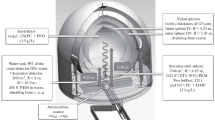Abstract
Borexino is a unique detector able to perform measurement of solar neutrinos fluxes in the energy region around 1 MeV or below due to its low level of radioactive background. It was constructed at the LNGS underground laboratory with a goal of solar 7Be neutrino flux measurement with 5% precision. The goal has been successfully achieved marking the end of the first stage of the experiment. A number of other important measurements of solar neutrino fluxes have been performed during the first stage. Recently the collaboration conducted successful liquid scintillator repurification campaign aiming to reduce main contaminants in the sub-MeV energy range. With the new levels of radiopurity Borexino can improve existing and challenge a number of new measurements including: improvement of the results on the Solar and terrestrial neutrino fluxes measurements; measurement of pp and CNO solar neutrino fluxes; search for non-standard interactions of neutrino; study of the neutrino oscillations on the short baseline with an artificial neutrino source (search for sterile neutrino) in context of SOX project.
Similar content being viewed by others
References
G. Alimonti et al. (Borexino Collaboration), “Science and technology of Borexino: a real time detector for low energy solar neutrinos,” Astroparticle Physics 16, 205 (2002).
G. Alimonti et al. (Borexino Collaboration), “The Borexino detector at the Laboratori Nazionali del Gran Sasso,” Nucl. Instrum. Meth. Phys. Res., A 600, 568 (2009).
G. Bellini et al. (Borexino Collaboration), “First real time detection of Be7 solar neutrinos by Borexino,” Phys. Lett. B 658, 101 (2008).
A. Arpesella et al. (Borexino Collaboration), “Direct measurement of the 7Be solar neutrino flux with 192 days of Borexino data,” Phys. Rev. Lett. 101, 091302 (2008).
G. Bellini et al. (Borexino Collaboration), “Precision measurement of the 7Be solar neutrino interaction rate in Borexino,” Phys. Rev. Lett. 107, 141302 (2011).
G. Bellini et al. (Borexino Collaboration), “Measurement of the solar 8B neutrino rate with a liquid scintillator target and 3 MeV energy threshold in the Borexino detector,” Phys. Rev. D 82, 033006 (2010).
G. Bellini et al. (Borexino Collaboration), “Absence of day-night asymmetry of 862 keV 7Be solar neutrino rate in Borexino and MSW oscillation parameters,” Phys. Lett. B 707, 22 (2012).
H. Back et al. (Borexino Collaboration), “CNO and pep neutrino spectroscopy in Borexino: Measurement of the deep-underground production of cosmogenic 11C in an organic liquid scintillator,” Phys. Rev. C 74, 045805 (2006).
G. Bellini et al. (Borexino Collaboration), “First evidence of pep solar neutrinos by direct detection in Borexino,” Phys. Rev. Lett. 108, 051302 (2012).
N. Grevesse and A. J. Sauval, “Standard solar composition,” Space Sci. Rev. 85, 161 (1998).
M. Asplund, N. Grevesse, A. J. Sauval, and P. Scott, “The chemical composition of the Sun,” Ann. Rev. Astron. Astrophys. 47, 481 (2009).
A. M. Serenelli, W. C. Haxton, and C. Pena-Garay, “Solar models with accretion. I. Application to the solar abundance problem,” Astrophys. J. 4, 7432 (2001).
G. Bellini et al. (Borexino Collaboration), “SOX: short distance neutrino oscillations with BoreXino, Borexino collaboration,” JHEP 038, 1308 (2013).
A. Palazzo, “Phenomenology of light sterile neutrinos: a brief review,” Mod. Phys. Lett. A 28(7), 1330004 (2013).
Author information
Authors and Affiliations
Corresponding author
Additional information
Talk at the International Workshop on Prospects of Particle Physics, “Neutrino Physics and Astrophysics”, Valday, Russia, January 26–February 02, 2014.
The article is published in the original.
Rights and permissions
About this article
Cite this article
Smirnov, O., Bellini, G., Benziger, J. et al. Solar neutrino with Borexino: Results and perspectives. Phys. Part. Nuclei 46, 166–173 (2015). https://doi.org/10.1134/S1063779615020185
Published:
Issue Date:
DOI: https://doi.org/10.1134/S1063779615020185



